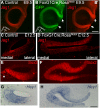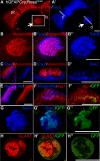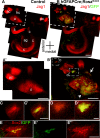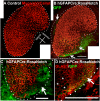Notch signaling specifies prosensory domains via lateral induction in the developing mammalian inner ear
- PMID: 20798046
- PMCID: PMC2936601
- DOI: 10.1073/pnas.1002827107
Notch signaling specifies prosensory domains via lateral induction in the developing mammalian inner ear
Abstract
During inner ear morphogenesis, the process of prosensory specification defines the specific regions of the otic epithelium that will give rise to the six separate inner ear organs essential for hearing and balance. The mechanism of prosensory specification is not fully understood, but there is evidence that the Notch intercellular signaling pathway plays a critical role. The Notch ligand Jagged1 (Jag1) is expressed in the prosensory domains, and mutation of Jag1 impairs sensory formation. Furthermore, pharmacological inhibition of Notch in vitro during prosensory specification disrupts the prosensory process. Additionally, activation of Notch by cDNA electroporation in chick otocysts results in formation of ectopic sensory patches. Here we test whether Notch activity is sufficient for prosensory specification in the mouse, using a Cre-/loxP approach to conditionally activate the Notch pathway in nonsensory regions of the inner ear epithelia during different stages of otic vesicle morphogenesis. We find that broad ectopic activation of Notch at very early developmental stages causes induction of prosensory markers throughout the entire otic epithelium. At later stages of development, activation of Notch in nonsensory regions leads to induction of sensory patches that later differentiate to form complete ectopic sensory structures. Activation of Notch in isolated nonsensory cells results in lateral induction of Jag1 expression in neighboring cells and spreading of prosensory specification to the adjacent cells through an intercellular mechanism. These results support a model where activation of Notch and propagation through lateral induction promote prosensory character in specific regions of the developing otocyst.
Conflict of interest statement
The authors declare no conflict of interest.
Figures





Similar articles
-
Notch signalling is needed to maintain, but not to initiate, the formation of prosensory patches in the chick inner ear.Development. 2007 Jun;134(12):2369-78. doi: 10.1242/dev.001842. Development. 2007. PMID: 17537801
-
Notch ligands with contrasting functions: Jagged1 and Delta1 in the mouse inner ear.Development. 2006 Apr;133(7):1277-86. doi: 10.1242/dev.02284. Epub 2006 Feb 22. Development. 2006. PMID: 16495313
-
Notch-mediated lateral induction is necessary to maintain vestibular prosensory identity during inner ear development.Dev Biol. 2020 Jun 1;462(1):74-84. doi: 10.1016/j.ydbio.2020.02.015. Epub 2020 Mar 5. Dev Biol. 2020. PMID: 32147304 Free PMC article.
-
Notch signaling and the developing inner ear.Adv Exp Med Biol. 2012;727:161-73. doi: 10.1007/978-1-4614-0899-4_12. Adv Exp Med Biol. 2012. PMID: 22399346 Review.
-
Notch Signalling: The Multitask Manager of Inner Ear Development and Regeneration.Adv Exp Med Biol. 2020;1218:129-157. doi: 10.1007/978-3-030-34436-8_8. Adv Exp Med Biol. 2020. PMID: 32060875 Review.
Cited by
-
Chromatin remodeler CHD7 is critical for cochlear morphogenesis and neurosensory patterning.Dev Biol. 2021 Sep;477:11-21. doi: 10.1016/j.ydbio.2021.05.009. Epub 2021 May 15. Dev Biol. 2021. PMID: 34004180 Free PMC article.
-
Jagged-Delta asymmetry in Notch signaling can give rise to a Sender/Receiver hybrid phenotype.Proc Natl Acad Sci U S A. 2015 Feb 3;112(5):E402-9. doi: 10.1073/pnas.1416287112. Epub 2015 Jan 20. Proc Natl Acad Sci U S A. 2015. PMID: 25605936 Free PMC article.
-
Characterization of Hair Cell-Like Cells Converted From Supporting Cells After Notch Inhibition in Cultures of the Organ of Corti From Neonatal Gerbils.Front Cell Neurosci. 2018 Mar 20;12:73. doi: 10.3389/fncel.2018.00073. eCollection 2018. Front Cell Neurosci. 2018. PMID: 29662441 Free PMC article.
-
Requirement for Jagged1-Notch2 signaling in patterning the bones of the mouse and human middle ear.Sci Rep. 2017 May 31;7(1):2497. doi: 10.1038/s41598-017-02574-7. Sci Rep. 2017. PMID: 28566723 Free PMC article.
-
The Notch Ligand Jagged1 Is Required for the Formation, Maintenance, and Survival of Hensen's Cells in the Mouse Cochlea.J Neurosci. 2020 Dec 2;40(49):9401-9413. doi: 10.1523/JNEUROSCI.1192-20.2020. Epub 2020 Oct 30. J Neurosci. 2020. PMID: 33127852 Free PMC article.
References
-
- Adam J, et al. Cell fate choices and the expression of Notch, Delta and Serrate homologues in the chick inner ear: Parallels with Drosophila sense-organ development. Development. 1998;125:4645–4654. - PubMed
-
- Lewis AK, Frantz GD, Carpenter DA, de Sauvage FJ, Gao WQ. Distinct expression patterns of Notch family receptors and ligands during development of the mammalian inner ear. Mech Dev. 1998;78:159–163. - PubMed
-
- Morrison A, Hodgetts C, Gossler A, Hrabé de Angelis M, Lewis J. Expression of Delta1 and Serrate1 (Jagged1) in the mouse inner ear. Mech Dev. 1999;84:169–172. - PubMed
-
- Murata J, Tokunaga A, Okano H, Kubo T. Mapping of Notch activation during cochlear development in mice: Implications for determination of prosensory domain and cell fate diversification. J Comp Neurol. 2006;497:502–518. - PubMed
Publication types
MeSH terms
Substances
Grants and funding
LinkOut - more resources
Full Text Sources
Other Literature Sources
Molecular Biology Databases

